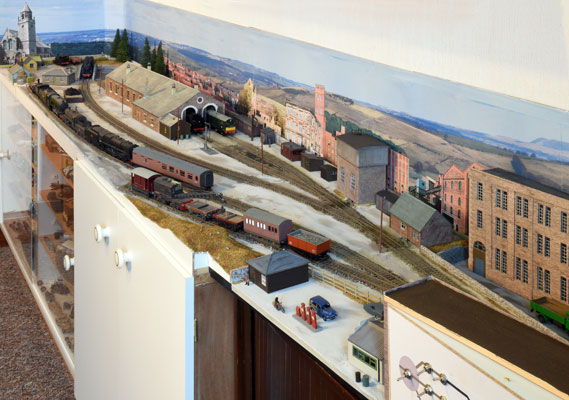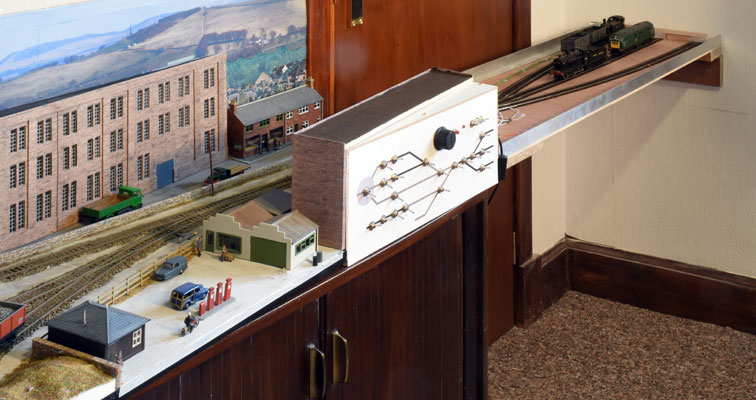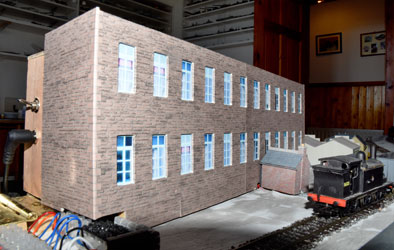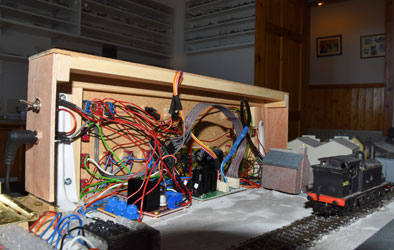This is my new model railway, built along one side of a spare room. It's OO gauge with finescale track. Ultimately I would like to have a huge railway up in the attic with continuous running, but for now I just wanted somewhere to display my collection of locomotives. Some of these are plastic kits from Airfix, or static engines where I've stolen the mechanism for use in other projects. I also have a few ancient models with wheel flanges which are too big for the finescale track - they just bump along over the sleepers. I made slow progress on construction until the great corona virus emergency of 2020, still ongoing as I type this, when I found myself with a lot of time on my hands. So now it's pretty much finished.
I've never been one for thinking up names for my railways but I thought I'd better make an effort, so this is called Pathhead Shed. It's a medium-sized railway shed "somewhere in Scotland", though knowledgeable readers may recognise the engine shed as having chimneys in the style of the Highland Railway. I based it on the one at Wick, estimating the dimensions from the rough plan and photographs in a book.
I attempted to convey the impression that my railway is a small element of a much bigger reality, instead of a 18" x 9' 4" (45 x 285 cm) rectangle. To this end, I tried to avoid having track or buildings aligned with the baseboard edges. Also, most of the railway is raised up above the tops of the cabinets on which it is built, with the background lower down as if receding into the distance. This also ties in with the name as Pathhead is an area of the town where I grew up, reached from the town centre by a steep slope known as "The Path". Consequently it is higher up than some of the surrounding area.
The backscene is constructed from photographs of the view from my old house, with more pictures of buildings stuck on top. In some cases it took more than one attempt to get a consistent scale and viewpoint. I think it works out okay, though some of the joins are more noticeable than I would like.
There's a set of sidings (known in the hobby as a "fiddle yard") built on a folding section which would otherwise block access to a box room. It's there so the trains have somewhere to go, or arrive from.
The control panel mimics the track layout, with point and section switches built in. The speed controller is home-made, constructed from an Arduino microcontroller driving a dual motor driver bought off A Well-Known Internet Retailer. Only one half of the driver is used, but at £4.53 for two of them this wasn't extravagant. Actually, there is a supplementary speed dial at the other end of the layout for convenient shunting, but this works as an alternative to the main one in the control panel. This is easily achievable in software. Another thing I took advantage of the microcontroller for is the red power light which flashes if a short is detected. There's a reset button to press once the problem has been resolved. Some of my older engines with overscale wheels were prone to triggering this on the points, so I added a capacitor to implement a slight delay, and reduced the sensitivity in software. I've thought of other things I could add to the control panel but they'll have to wait for a mid-life update. The whole lot runs off a re-purposed 19V laptop supply, with 5V and 12V regulators for the Arduino and the motor driver.
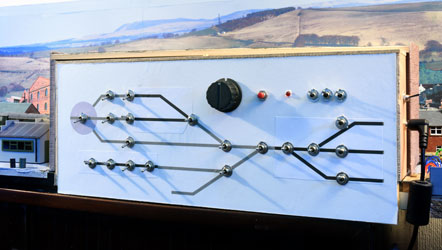
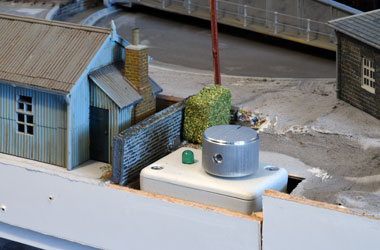
The back of the control panel is hidden behind a factory unit, scratch built from card. The windows are not actually transparent, but are photoshopped versions of real windows in a old factory near my house. The wiring is a bit of a rat's nest to be honest, though most of the components are screwed down as neatly as I could manage. The exception is the Arduino, which doesn't have suitable mounting holes and consequently is floating about loose.
I have a large collection of buildings, some from previous railways, others which I built just because I like making things. In practice only a small number of them could be used on this layout, sheds and huts mostly. I ended up constructing some more just for this railway. Apart from the engine shed and the factory at the back of the control panel, there's also a new water tower and a coaling stage. Four point motors are hidden underneath strategically located buildings, some of which needed adapted to give clearance to the mechanism.
One reason I chose Wick for inspiration was that its turntable was located beyond the engine shed instead of in front. This is what I needed for my railway as the turntable is almost the same width as the cabinets on which it's built, and squeezing track past it would be problematic. The turntable is a heavily modified Airfix kit, chosen because it was one of the few Airfix buildings I hadn't already constructed. The deck has been cut down and the ends rounded off. (A rectangular deck wouldn't rotate, which is a major flaw.) The original handrails were simple posts to which the modeller was expected to add thread. They were replaced by Ratio stanchions, which are moulded with holes through which I could fit brass handrail wire. The track is made from rails with individual chairs threaded on. They're wired to phosphor bronze wipers on the underside which collect current from brass terminals on either side of the mounting axle. That way the polarity is the correct way round when the turntable is rotated.
My previous railway had a sad lack of humans, looking like it was in the middle of a virus outbreak, so this time I set about painting some tiny people I had in store since the nineties. Sometimes it just takes a little while for things to rise to the top of my to-do list. There's a bunch of people outside the shops, various railway workers around the shed, and a railway enthusiast sitting on the wall over by the turntable. Meanwhile, a woman is resting on some cases in front of the garage. She doesn't look very happy - maybe the car has broken down again.
There are still some small tasks to be completed, and a couple of problems to resolve, but for now my railway is pretty much finished. I might be able to think of some details to add, in which case I will update this web page.
More pictures | Construction photographs | Old model railway | More railway pictures | Main page
